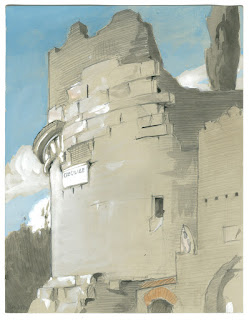 |
| Looking north on the via Appia Antica in the afternoon |
THE CLASSICAL LANDSCAPE IS A REAL PLACE
Spending two months this summer in
Rome just outside the Aurelianic walls afforded relatively easy access to both
those magical ancient roads leading into the city from the Porta S. Sebastiano
and Porta Latina, and the via Appia Antica which led out from the Porta S.
Sebastiano (so-called because it led to the pilgrimage church of S.
Sebastiano). The via Appia has been a destination for plein air artists for
centuries, and despite way too much (and two-way!) traffic in the first stretch
outside the walls, it becomes quiet, and profoundly evocative, for miles on.
One of the essential sites along the road is the tomb of Cecilia
Metella, incorporated in the Middle Ages
into a Caetani family stronghold. Despite the prominent inscription to the
Roman matron for whom it was built, the building was known as the Capo di Bove
through the eighteenth century because of the bull skulls, or bucrania (capo
head bove bull) that ornament the frieze.
 |
| 18th century French view |
Artists have been drawing and
painting the tomb of Cecilia Metella for centuries, but perhaps most
compellingly in the eighteenth. And she then shows up in a variety of
capricious landscapes, a recognizable landmark transposed to very different
contexts, including seasides. What was the appeal, given there were so many
suggestive remains along the via Appia? Part of it, I would argue, is the round
form, albeit fragmented. Like a kind of sundial, the tomb’s shadows track the
sun’s path across the arc of the day, its varied aspects (owing to differing
states of ruin or infill) and orientations to context—the Appia on one side,
the overgrown remains of the Circus of Maxentius on the opposite side—made it a
rewarding subject to depict from different angles at different times of day.
 Since I had the luxury of returning
to the site several times, I took a more deliberate tack than I usually do,
starting first with pencil drawings on toned Magnani™ Annigoni paper
highlighted with white gouache (and occasionally black, as I did for the Arco di
Druso). For the first version I couldn’t resist introducing the blue sky,
and warm brick color; but I subsequently resisted introducing color, and for some
studies elsewhere relied on black mixed with white for the sky, the cool grey functioning
as an effective blue. Only after several drawings did I start in oil, the first
on prepared paper, the second on canvas board. The images shown here are all
from the via Appia side; I did both draw and paint from the Circus of Maxentius
(part of the emperor’s villa complex, now visitable), but I’ll save those for a
subsequent post.
Since I had the luxury of returning
to the site several times, I took a more deliberate tack than I usually do,
starting first with pencil drawings on toned Magnani™ Annigoni paper
highlighted with white gouache (and occasionally black, as I did for the Arco di
Druso). For the first version I couldn’t resist introducing the blue sky,
and warm brick color; but I subsequently resisted introducing color, and for some
studies elsewhere relied on black mixed with white for the sky, the cool grey functioning
as an effective blue. Only after several drawings did I start in oil, the first
on prepared paper, the second on canvas board. The images shown here are all
from the via Appia side; I did both draw and paint from the Circus of Maxentius
(part of the emperor’s villa complex, now visitable), but I’ll save those for a
subsequent post.
For the oils I’m showing some of the
steps in the process. My technique is almost always to start with the sky;
working on a toned ground I often then move to the lights, modeling the form in
shade and dealing with the materials, and generally dealing with the shadows
proper near the end. The last touches are really calibrations, pushing and
pulling the lights and darks. Again, working within Valenciennes’ two hour
window, there’s no small amount of editing necessary, and light is a transient
phenomenon whose principal effect is shadows. As an architect as well as
painter, I prefer the shadows to be consistent with a more or less single light
orientation, which means they need to be done within a short period of time.









No comments:
Post a Comment